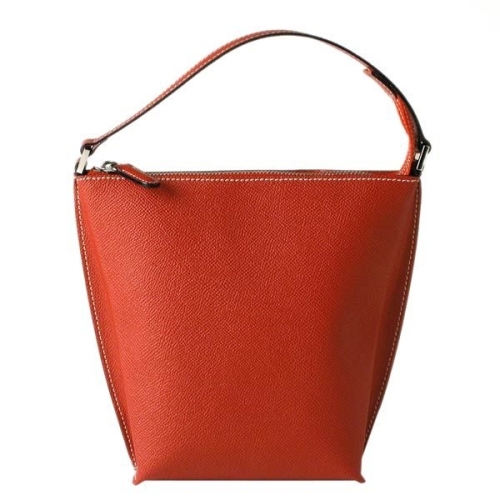Dimensions: approximately 10″ high / 12″ wide / 4″ deep with a 20″ [51 cm] pivoting strap handle and zippered opening. [25.5 cm x 30.5 cm x 1 cm]
Construction Method: Cut edge finish – the edges are not skived or turned over; the full thickness of the material used is retained and its edges are usually stained and polished. Keep the styling simple in design as all the construction is done by hand.
Material Used: cowhide leather
You will need:
- 1 pair of metal square loop brackets, 1” dia. [25 mm]
- 1 metal closed zipper, 16” long [41 cm]
- 1 cowhide or garment leather skin, 4-10 oz.
- 1 spool of waxed linen thread
- 2 harness needles
- Leather punch or awl
- Leather polish
- Beeswax or clear paraffin
- Fine-grade emery paper
- X-acto knife
- Kraft paper
Design Tip: Match the colour and surface finish of the metal hardware with the zipper metal.
PATTERN
Click on illustration to magnify
The draft and proportions of this handbag is based upon a simple flat grid, which fits into a square or rectangle, of which the size depends on the desired depth of the style.
Scale = X = the depth of the bag; the prototype is 4″ deep [10 cm].
CUTTING
Tanned leather is sold by weight per square foot. Therefore, one-ounce leather weighs one ounce per square foot, two-ounce leather weighs two ounces per square foot and likewise for other weights. One-ounce leather is approximately 1/64-inch thick, two-ounce leather is 1/32-inch (or 2/64”), and the measurement continues to get thicker with heavier weights. Leather is usually sold by the hide, half-hide or by parts such as back or shoulder and charged per square foot.
The first step is to choose the perfect hide of leather. The skin must be free of any defects like growth marks or nicks. You will have to lay out the pattern pieces in such a way as to avoid tears and the imperfections. The pattern draft may have to be divided so that both the back and front planes will look exactly the same. Even in one hide there are many variations that might cause the two surfaces not to match. Chalk-mark location of blemishes on underside of leather to avoid them when laying out the pattern.
BAG BODY – cut 1X
STRAPPING – cut 2X
TAB & LOOPS – cut 3” long X 1” wide [75 mm X 25 mm]
Cut the body of the bag in the center of the skin and cut the strapping for the handle, one on either side of center along the underbelly where the leather hide is a bit thinner. Use the remnant to cut the loops and tabs. Layout and mark the pattern on the wrong side of the leather skin.
Use an x-acto knife or rotary cutter and metal straight edge to cut leather with neat straight edges. Cut the pieces using a sharp new blade. (Be certain to provide a cutting mat or a backing of cardboard to protect tabletops.) Hold the knife or rotary cutter so the cut edge is perpendicular to the face of the leather. The actual art of the cutting is quite subtle. Depending on whether a cut is fairly straight or very rounded you will either cut with the knife or leave the knife stationary and move the leather. Any experienced hand does this all so quickly that it seems quite simple. But it isn’t; use a steady hand. When cutting thick leather, make several passes with the blade, being careful to follow the previous cut.
ASSEMBLY
Cut edge bag construction is generally similar for all projects with one important exception: the edges are not skived or turned over; note that there are no seam allowances. The full thickness of the material used is retained and its edges are aligned with seams on the outside of the bag. The stitch holes along the edge of the leather are pre-punched and sewn with saddle-stitching.
 For thick leather, begin by making the stitch lines a scant l/4 inch [5 mm] from the edge. Using an awl or punch, make regularly spaced holes through the leather. If possible, glue pieces together with double-sided mounting tape as they will be stitched. This will assure proper alignment of stitch holes. Consistent holes are important so seams do not pucker. Drive the awl by hand; drive the punch with a
For thick leather, begin by making the stitch lines a scant l/4 inch [5 mm] from the edge. Using an awl or punch, make regularly spaced holes through the leather. If possible, glue pieces together with double-sided mounting tape as they will be stitched. This will assure proper alignment of stitch holes. Consistent holes are important so seams do not pucker. Drive the awl by hand; drive the punch with a  mallet. When punching the leather, strive for uniformity, but recognize that small inconsistencies are the mark of human craftsmanship.
mallet. When punching the leather, strive for uniformity, but recognize that small inconsistencies are the mark of human craftsmanship.
- Stitch the body’s side seams, then miter the bottom to the sides. Set aside.
- Stitch the strapping one on top of each other with ends of top layer wrapped around a loop bracket. Skive the short ends to make the
 turnings. Apply the underside layer of the strapping and trim away excess to neaten and hold the brackets in place.
turnings. Apply the underside layer of the strapping and trim away excess to neaten and hold the brackets in place. - Stitch leather loops to each bracket.
- Stitch strapping to inside edge the bag opening across each side seam.
- Stitch tab to end of zipper tape.
- Stitch zipper to inside edge of bag opening and extend the end of the zipper to create a grip tab on the bag.
For all stitching, begin by cutting a length of linen thread about an arm’s length. If the thread is not pre-waxed, wax it now by passing it several times across a cake of beeswax or paraffin. Thread both ends of the thread with needles to do the saddle stitch. When sewing a single thickness of thread, pass the strand through the needle’s eye and pull several inches through. Twist this end around the main thread.
Always begin and end seams by backstitching. Backstitching is a technique for beginning and ending a seam, or joining a new piece of thread into the seam. The purpose of backstitching is to lock the thread and prevent unraveling at the ends of the seam.
The saddle stitch requires a single thickness of thread with harness or round needles at both ends. It is recommended for pre-punched stitches since both needles pass through the same holes.
 Begin saddle stitch by passing one needle through the aligned holes at one end of the seam. Pull through until there are equal amounts of thread on both sides of the leather. Take one needle and start it through the next stitch hole from the same side of the leather. Start the other needle through the same hole from the opposite side. Grasp both needles and pull through until the stitch is taut. Put equal tension on both needles. Repeat the procedure at the next stitch hole and so on until the end of the seam.
Begin saddle stitch by passing one needle through the aligned holes at one end of the seam. Pull through until there are equal amounts of thread on both sides of the leather. Take one needle and start it through the next stitch hole from the same side of the leather. Start the other needle through the same hole from the opposite side. Grasp both needles and pull through until the stitch is taut. Put equal tension on both needles. Repeat the procedure at the next stitch hole and so on until the end of the seam.
Sewing Tip: If possible, grip the leather pieces between your knees so that the work is perpendicular to the floor. This makes it easier to pass the needles back and forth.
FINISHING
Once all of the seams are sewn, the project is ready for finishing. Finish leather seams by gently smoothing down raw edges with emery paper. Protect exposed edges by rubbing briskly with beeswax, or polishing with leather polish.





wonderfull, gorgeous,I love this blog,
Thx Suzanne
The bag is simple yet elegant. Cannot wait to try it. And thanks for coming back, we missed you.
Thx Laurie.
Thank you so much for your great ideas and detailed instructions. Do you have any suggestions for sources for leather? Any help would be very much appreciated! Thank you.
Thx Karen… only suggestion that I can make is to check your local suppliers but if you get a chance to travel you’ll find great leather from Spain and Brazil to bring back as souvenirs.
D.
Pingback: Links zum Eintragen | Kostenlose-Schnittmuster.de
I living in spain now and it’s true the leather is fantastic… great work !!!!
Thx Jabali…..great custom bags by the way.
Perfect timing. I am going to Spain at the end of the month. Now I know what to look for. Tnx for this Don. This is such a simple but elegant bag.
wonderful bag! thank you so much for the tutorial!
many greetings from Austria!
elenor
Pingback: The Leather District | Grey's Fabric and Notions
This is one of the best blogs I have ever read. Your designs look very well made, the instructions are clear and the information you are passing through is invaluable. Many thanks for making the effort to share your knowledge!
Etemi
Thank you Etemi, kind of you to say. I hope you will try your hand at designing your own.
very nice bags
I want to make this bag terribly!!!! But it would be my first leather project, don’t have the tools or know which leather to get. I need a class!!??
Terri, I’m working on a new “leather” project that may help. Stay tuned as I will announce it soon.
I will be hanging on every post.
Thx Terri
Don – new to blog and love it! Have you announced your new leather project yet?
Thanks Christie…any day now.
just found your blog can’t wait to create one of your designs. I saw your class too, how many patterns do you receive when taking class?
Vicki in Vegas 🙂
Pingback: How to Make a Saddle-Stitched Handbag – Free Tutorial + Pattern | PatternPile.com - Hundreds of Patterns for Making Handbags, Totes, Purses, Backpacks, Clutches, and more.
Beautiful and simple!
Thank you, Donna
Reblogged this on conlemanieconilcuore.
Is the template for the bag that’s shown? It looks completely different. If not, do you have the template for the bag in the pictures? Thank you!
Yes Rob that is the pattern for the handbag shown in my tutorial though you may change the proportions to suit your own needs.
Hi Don I just wanted to write to thank you so much for this wonderful blog and for your previous blog Weekend Designer. It is such a kind thing to do to use your talent and expertise to help others in this way and I wanted to let you know I truly appreciate it xx
Thanks for the kind words, Chamali
Any tips for sewing in the zipper?
May I purchase this already made from you? Thank you!
Sorry Pam. This bag design is not available.
Pingback: How to Make a Saddle-Stitched Handbag – Free Tutorial + Pattern | PatternPile.com